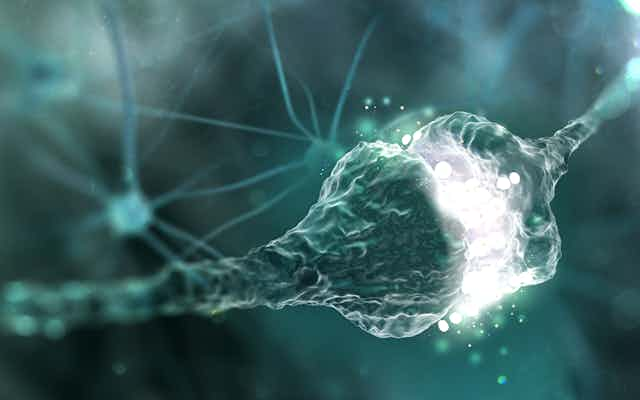The relationship between mind, brain and body has kept philosophers and scientists busy for centuries. Some of the first interesting – albeit gruesome – experiments on the role of the body in human consciousness considered life after decapitation.
In 1905, French physician Dr Gabriel Beaurieux believed he had communicated with prisoner Henri Languille after his head had been severed from his body. Writing of the experience, Beaurieux said:
I called in a strong, sharp voice: “Languille!” I saw the eyelids slowly lift up, without any spasmodic contractions – I insist advisedly on this peculiarity – but with an even movement, quite distinct and normal, such as happens in everyday life, with people awakened or torn from their thoughts.
Almost two decades later, Soviet scientist Sergei Brukhonenko reportedly kept a dog’s severed head alive for nearly six months using a primitive heart-lung machine. Video footage allegedly shows the head responding to light, sound and citric acid stimuli. But while Brukhonenko’s research may have been an important in the development of cardiac surgery – it is also regarded as faked Soviet-era propaganda.
Consciousness and non-physical properties
Investigations into human consciousness have moved on since these initial observations – though we haven’t got away from decapitation just yet. More recently, however, neuroscientists have questioned just how it is that physical matter comes together to make the mind.
In 1995, Dr Francis Crick wrote in his The Astonishing Hypothesis that we are nothing more than an “immensely complex collection of neurons”. This theory is a form of reductive physicalism – a philosophical position to which modern neuroscience typically subscribes – that everything in existence is no more than its physical properties.
Again using animal decapitation, though this time with rats, neuroscientists have explored the question of how long brain activity is observed after death – a step forward from investigating consciousness.
In a 2011 experiment, it was reported that decapitated rats’ time to unconsciousness – defined by a decrease in cognitive activity of 50% – was four seconds. The researchers also observed a very large and much later slow wave in brain activity. This was interpreted as what they called a “wave of death” – when all the brain’s neurons died at the same time – and perhaps, the ultimate border between life and death.
But some believe that the mind is more than just the sum of its physical brain cells. A contrasting position to physicalism is the dualist assumption that the physical and the mental are fundamentally different substances.
Furthermore, some philosophers and scientists have suggested that “information may be the key to consciousness”. Consistent with this idea is integrated information theory, which accepts the existence of consciousness, but controversially implies that anything at all may be conscious – even a smartphone – if it possesses a sufficiently high “phi”: a measure of information in a system which cannot be reduced to that specified by its parts.
From psychological moments to mortality
While I have left out many important details in this fascinating discussion, better understanding the link between mind, brain and body has been the focus of my own research, in recent years through looking at the functions of the vagus nerve.

Higher vagus nerve function (measured and indexed by heart rate variability) supports a person’s capacity for emotion regulation, social engagement and cognitive function. By contrast, impaired vagal function – and lower heart rate variability – may play a role in the onset of depression.
But the vagus nerve doesn’t just affect the mind. Higher levels of vagal function may lead to improved glucose regulation, reduced inflammation, and reduced risk of disease and death.
Vagal function is also known to play an important role in brain cognition. It helps to suppress irrelevant and interfering stimuli. Studies have also suggested that the vagus nerve might play an important regulatory role over inflammatory processes, contributing to diabetes, obesity and cardiovascular disease – all of which also impact on cognitive function.
However, little research has been done which looks at how the vagus nerve affects body and mind together. That’s why I teamed up with colleagues to question whether previously reported relationships between vagal function and cognitive performance could be explained through a single physiological pathway.
Supporting this possibility, we observed that impairment in vagal function appears to increase insulin resistance, which contributes to a thickening of the carotid arteries, which in turn adversely impacts on cognitive function. This means that low vagal function initiates a cascade of adverse downstream effects which subsequently lead to cognitive impairment.
While simple health behaviours – weight loss and exercise for example – may “short circuit” adverse effects on brain function, more research into the causal pathways involved is needed to discover just how the vagus nerve connects the body, brain and mind.
Our research is a first step into uncovering how the health of the body and mind can be affected by this one nerve. But it is one step on a path that we hope will develop with our own research into “positive psychology” for people living with neurological disorders.

